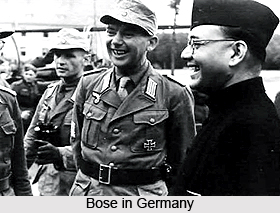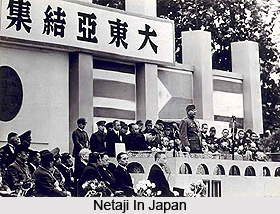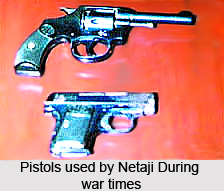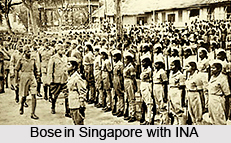 Through the INA Subhas Chandra Bose persuaded the British to think about India`s Independence. His various instructions given to the soldiers reflect his immense dedication towards attaining independence for India. This marks perhaps the most significant event in the annals of India`s fight for independence.
Through the INA Subhas Chandra Bose persuaded the British to think about India`s Independence. His various instructions given to the soldiers reflect his immense dedication towards attaining independence for India. This marks perhaps the most significant event in the annals of India`s fight for independence.
On 17 February 1942, two days after the Fall of Singapore, some 45,000 Indian Prisoners-Of-War (POWs), were gathered at Farrer Park. There, the British handed them over to the Japanese. To their surprise, the Japanese welcomed them and pledged their support for India`s Independence. Following this, Mohan Singh, a captain in the Punjab Regiment in the British Army, called upon the Indians to form an army to free India. Almost 20,000 soldiers immediately came forward to join what became the Indian National Army (INA).
The INA or Azad Hind Fauj was an armed force formed by Indian nationalists in 1942. The aim of the army was to overthrow the British Raj in colonial India, with Japanese assistance. Initially composed of Indian prisoners of war captured by Japan in her Malayan campaign and at Singapore, it later drew large numbers of volunteers from Indian expatriate population in Malaya and Burma.
 In early March 1942, the Japanese proposed that the INA become the military arm of the Indian Independence League (IIL), and Rash Behari Bose, an Indian revolutionary who had earlier fled to Japan, lead the movement. This was formally announced in June 1942 in Bangkok. By late 1942, the Indians increasingly felt that the Japanese were making use of them and they distrusted Rash Behari Bose. In December, Mohan Singh and other INA leaders ordered the INA to split up after severe disagreements with the Japanese. Mohan Singh was subsequently arrested by the Japanese and exiled to Pulau Ubin.
Nevertheless, when Subhas Chandra Bose arrived in the Far East in 1943, he revitalized the idea of a liberation army. In July, at a meeting in Singapore, Rash Behari Bose handed over control of the organisation to Subhas Chandra Bose. The Army consisted of some 85,000 regular troops including a separate women`s unit named after Rani Lakhmi Bai which was the first women`s combat army unit of its kind in Asia. These troops were under the patronage of a provisional government, with its own currency, court and civil code, called the "Provisional Government of Free India" or the Arzi Hukumat-e-Azad Hind.
In early March 1942, the Japanese proposed that the INA become the military arm of the Indian Independence League (IIL), and Rash Behari Bose, an Indian revolutionary who had earlier fled to Japan, lead the movement. This was formally announced in June 1942 in Bangkok. By late 1942, the Indians increasingly felt that the Japanese were making use of them and they distrusted Rash Behari Bose. In December, Mohan Singh and other INA leaders ordered the INA to split up after severe disagreements with the Japanese. Mohan Singh was subsequently arrested by the Japanese and exiled to Pulau Ubin.
Nevertheless, when Subhas Chandra Bose arrived in the Far East in 1943, he revitalized the idea of a liberation army. In July, at a meeting in Singapore, Rash Behari Bose handed over control of the organisation to Subhas Chandra Bose. The Army consisted of some 85,000 regular troops including a separate women`s unit named after Rani Lakhmi Bai which was the first women`s combat army unit of its kind in Asia. These troops were under the patronage of a provisional government, with its own currency, court and civil code, called the "Provisional Government of Free India" or the Arzi Hukumat-e-Azad Hind.
Among the masses attending Bose`s rally was Dr. Lakshmi, who responded immediately to his appeal to form a Women`s Regiment. She visited many families to persuade the women to join the INA. Many were reluctant because they firmly believed that the traditional role of a woman was to be at home. However, she managed to gather 20 enthusiastic girls who were willing to break those traditional barriers. The girls presented the guard-of-honour to Bose. He was impressed and invited Dr. Lakshmi to lead the Women`s Regiment.
 This second INA fought along with the Imperial Japanese Army against the British and the commonwealth forces. They were well-known among the nine Axis states-Germany, Japan, Italy, the Independent State of Croatia, Wang Jingwei`s Government in Nanjing, Thailand, a provisional government of Burma, Manchukuo and Japanese-controlled Philippines. When the Japanese pressed forward towards India through Burma, the INA`s troops assisted in the Japanese victory over the British in the battles of Arakan and Meiktila, along with the Burmese National Army led by Ba Maw and Aung San.
The INA were established in the Andaman and Nicobar Islands in the Bay of Bengal, part of the British Indian Empire under Japanese occupation, was renamed `Shaheed` (Martyr) and `Swaraj` (Self-rule). Bose visited the islands on just one occasion late in 1943, when he was carefully shielded from the local population by the Japanese authorities because at that time they were torturing the leader of the Indian Independence League on the Islands, Dr. Diwan Singh (who later died of his injuries, in the Cellular Jail). The islanders made several attempts to alert Bose to their unfortunate conditions, but they did not succeed.
This second INA fought along with the Imperial Japanese Army against the British and the commonwealth forces. They were well-known among the nine Axis states-Germany, Japan, Italy, the Independent State of Croatia, Wang Jingwei`s Government in Nanjing, Thailand, a provisional government of Burma, Manchukuo and Japanese-controlled Philippines. When the Japanese pressed forward towards India through Burma, the INA`s troops assisted in the Japanese victory over the British in the battles of Arakan and Meiktila, along with the Burmese National Army led by Ba Maw and Aung San.
The INA were established in the Andaman and Nicobar Islands in the Bay of Bengal, part of the British Indian Empire under Japanese occupation, was renamed `Shaheed` (Martyr) and `Swaraj` (Self-rule). Bose visited the islands on just one occasion late in 1943, when he was carefully shielded from the local population by the Japanese authorities because at that time they were torturing the leader of the Indian Independence League on the Islands, Dr. Diwan Singh (who later died of his injuries, in the Cellular Jail). The islanders made several attempts to alert Bose to their unfortunate conditions, but they did not succeed.
With the occurrence of the Great Bengal Famine in1943, this year was marked as an important year in Indian History. Millions died of starvation as a consequence of British inefficiency and indifference. Bose had offered through radio to provide Burmese rice to the victims of the famine. The British authorities in India and in the UK refused the offer, arguing that it was made for propaganda purposes only. This enraged Bose even more. He decided to come down heavily on the British government.
 Subhas Chandra Bose hoped that large numbers of soldiers would come to join the INA as soon as they would discover that INA were attacking the British India from outside. But this did not materialize on the expected scale. As the war situation worsened for the Japanese, troops began to desert from the INA. As a result Japanese funding for the army diminished, and Bose was forced to raise taxes on the Indian populations of Malaysia and Singapore, sometimes extracting money by force. The Provisional Government`s aim of establishing a base in mainland India was lost forever when the Japanese were defeated at the battles of Kohima and Imphal. The INA was forced to pull back, along with the defeated Japanese Army. Japan`s surrender also led to the eventual surrender of the Indian National Army.
Subhas Chandra Bose hoped that large numbers of soldiers would come to join the INA as soon as they would discover that INA were attacking the British India from outside. But this did not materialize on the expected scale. As the war situation worsened for the Japanese, troops began to desert from the INA. As a result Japanese funding for the army diminished, and Bose was forced to raise taxes on the Indian populations of Malaysia and Singapore, sometimes extracting money by force. The Provisional Government`s aim of establishing a base in mainland India was lost forever when the Japanese were defeated at the battles of Kohima and Imphal. The INA was forced to pull back, along with the defeated Japanese Army. Japan`s surrender also led to the eventual surrender of the Indian National Army.
In this situation Bose urged the people of India to join him in his fight against the British Raj. On July 4, 1944 spoken as a part of a motivational speech for the Indian National Army at a rally of Indians in Burma, his most illustrious quote was "Give me blood, and I shall give you Freedom". His other famous quote was, "Delhi chalo", meaning "On to Delhi!" This was the call he used to give the INA armies to motivate them. "Jai Hind" or, "Glory to India!" was another slogan used by him and later adopted by the Government of India and the Indian Armed Forces.






































